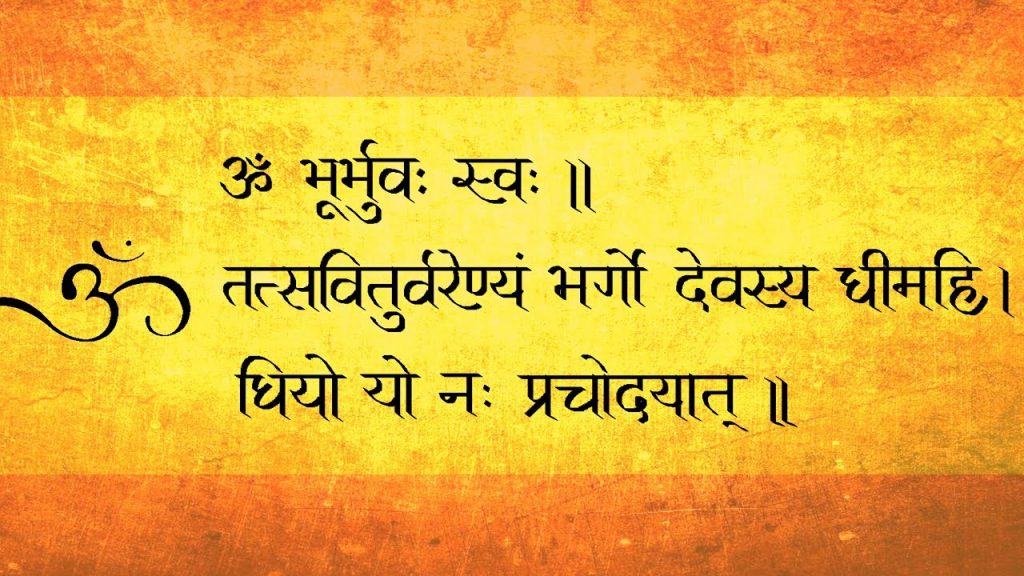
The Gayatri Mantra
ॐ भूर् भुवः सुवः ।
तत्स॑वि॒तुर्वरेण्यं
भर्गो॑ दे॒वस्य॑धीमहि ।
धियो॒ यो नः प्रचो॒दया॑त् ॥
om bhūr bhuvaḥ suvaḥ
tatsaviturvareṇyaṃ
bhargo devasyadhīmahi
dhiyo yo naḥ prachodayāt
– Rigveda 3.62.10
Aum is the pranav or sound that encompasses all. Bhu refers to Earth or body.
Bhuvah, refers to the atmosphere, subtle body. Svaha refers to beyond atmosphere, swargalok.
Tat simply means “that” which is the “Ultimate Reality.” Savitur means “Divine Sun” (the ultimate light of wisdom)
Varenium means “adore” Bhargo means “illumination”
Devasya means “Divine Grace”. Dheemahi means “we contemplate”
Dhiyo means intellect. Yo means “who” . Nah means “ours”
Prachodayat means “requesting /praying”
Gaya means “Vital energies” and trayte means “protects, preserves, grants liberation, gives deliverance.” In simple words, and language Gayatri means “May the divine light of the supreme being illuminate our intellect, so that we can tread on the path of righteousness”.
Gayatri is the Mother of all scriptures (Vedas). She’s present wherever her name is chanted. She’s very powerful. The One who nourishes the individual being is Gayatri. She bestows pure thoughts on anyone who worships her.
She is the embodiment of all Goddesses. Our very breath is Gayatri, our faith in existence is Gayatri. Gayatri has five faces, they are the five life principles. She has nine descriptions. They are ‘Om, Bhur, Bhuvah, Swah, Tat, Savitur, Vareñyaṃ, Bhargo, Devasya’.
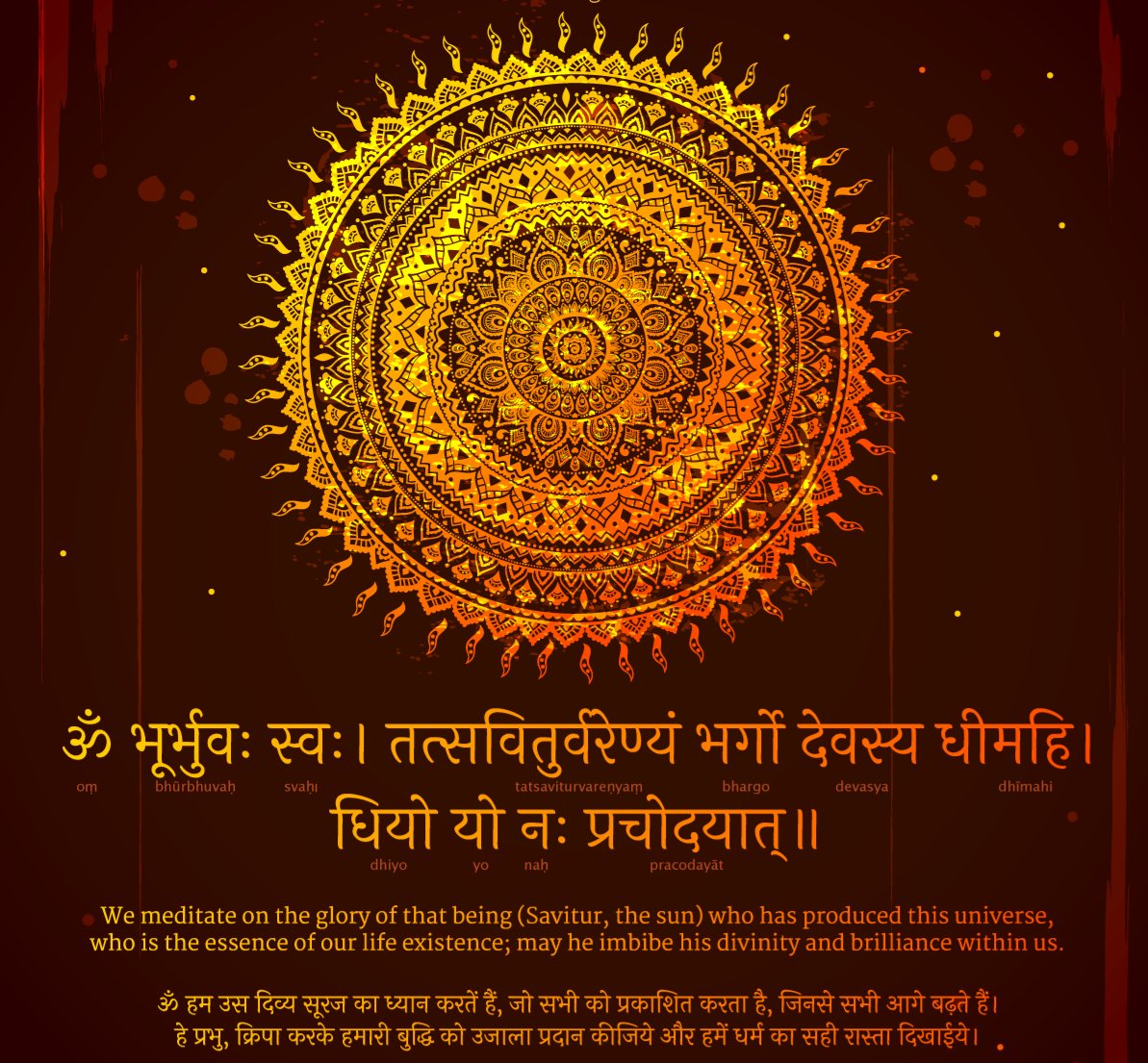
Mother Gayatri nourishes and protects every being and she channelizes our senses in the proper direction. ‘Dhīmahi’ means meditation. We pray to her to inspire us with good intelligence.
‘Dhīyo Yonah Prachodayāt’ – We beseech her to bestow on us everything we need. Thus Gayatri is a complete prayer for protection, nourishment and finally, liberation.
Gayatri mantra gets its name from the chhandas, or the meter which holds it. Gayatri chhandas, has three lines in it, with 8 syllables each.
Be it any version of the Gayatri mantra, it has to follow this rule of three lines, and 8 syllables.
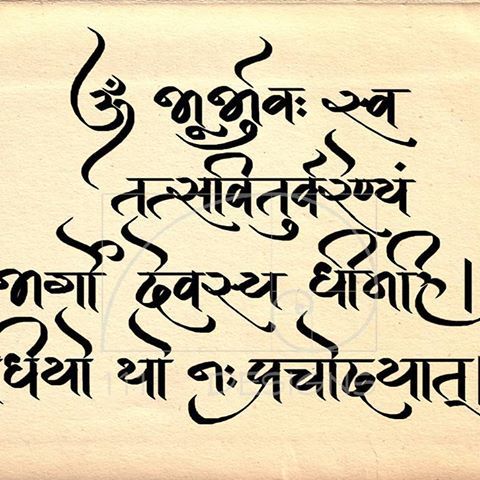
Gayatri is considered as the most sacred of all meters in Sanskrit grammar. It is praised as the mother of knowledge, “Gayatri chandasam mata“. One fourth of the entire Rig Veda, is composed in Gayatri chandas.
Before uttering a mantra, we start with remembering it’s corresponding sage, meter, divine entity and usage.
अस्य श्री गायत्री मंत्रास्य
विश्वामित्र ऋषि:
गायत्री छंद:
सविता देवता
जपोपनयाने विनियोग:
asya shri gayatri mantrasya, vishwamitra rshih, gayatri chandah, savita devata, japopanayane viniyogah
Here is a breakdown of the words of the Gayatri mantra…
ॐ
भू: भुव: स्व: तत् सवितु: वरेण्यम्
भार्ग: देवस्य धिमाहिधिय: य: न: प्रचोदयात्
Om bhuh bhuvah svah tat savtiuh varenyam
bhargah devasya dhimahi
dhiyah yah nah prachodayat
Aum, is the primordial sound – a combination of sounds corresponding to creation, maintenance and destruction.
The word भू: represents bhuloka, the material world in which we live.
भुव: represents the antariksha loka, which is the space in which the material world exists.
स्व: represents svarga loka, or a higher plane of existence. These need not just mean they represent three different worlds similar to earth. They also have a physiological significance and represent how gross or subtle we perceive life within our own self.
The word loka itself comes from the root word lochana, meaning that which we see. There are 14 such planes of existence which are recognised in the body and in the cosmos. In this version of the mantra, three of them are prominently mentioned.
We also notice that these three are mentioned in an increasing order of subtlety – भू: भुव: स्व:
The reason behind this special mention, called as व्याह्रिती(vyahriti), is to set the direction of one’s energies from gross to subtle.
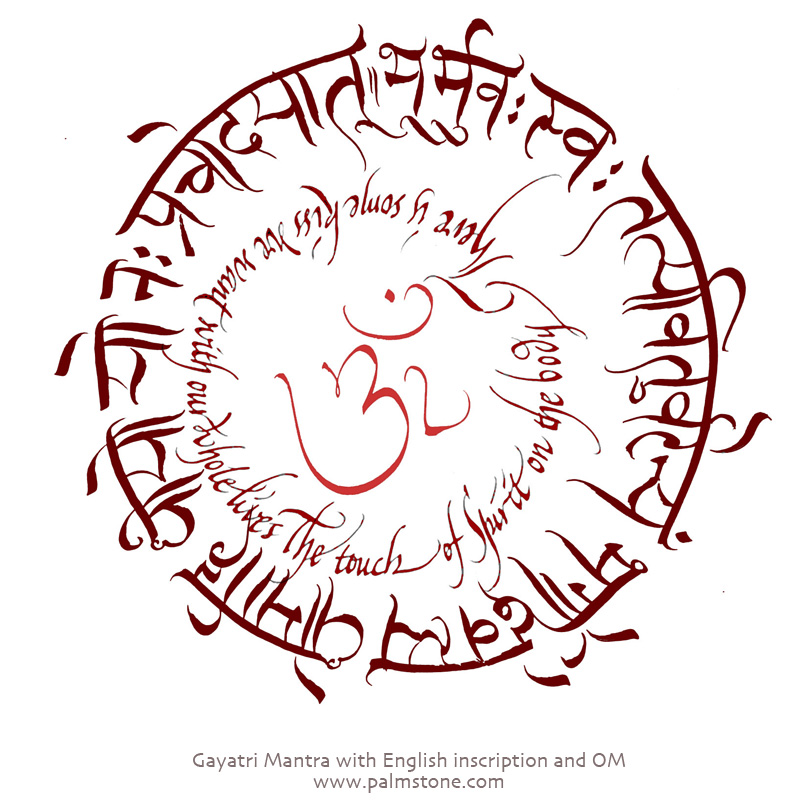
The next word we need to understand, is धिमाहि (dhimahi),which means “we meditate upon”.
What do we meditate upon?
तत्भार्ग: (tat bhargah)which means that brilliance.
We meditate upon that brilliance.
What kind of brilliance?
वरेण्यम्भार्ग: (varenyam bhargah),the highest kind of brilliance.
Whose brilliance is this?
देवस्य – of the divine entity.
Of which divine entity?
सवितु: वरेण्यम्भार्ग: (savituh varenyam bhargah) – of the divine entity who gave birth to life as we know it.
Why do we meditate on it?
प्रचोदयात् (prachodayat) – so that it may propel, or drive.
Drive what?
न: धिय: (nah dhiyah) – meaning our minds.
In which direction does it propel?
That has already been set by the व्याह्रिती (vyahriti) – भू: भुव: स्व: (bhuh bhuvah svah) – from gross to subtle direction.
Let’s now do an अन्वयक्रम (anvayakrama),or a re-ordering of words to understand the meaning easily.
धिमाहि तत् वरेण्यम् भार्ग:सवितु:देवस्य (dhimahi tat varenyam bhargah savituh devasya)
We meditate upon the highest brilliance of the source of life.
य: प्रचोदयात्न:धिय: (yah prachodayat nah dhiyah)
Which may propel our minds.
भू: भुव: स्व: (bhuh bhuvah svah)
from the material world to subtler planes of existence.
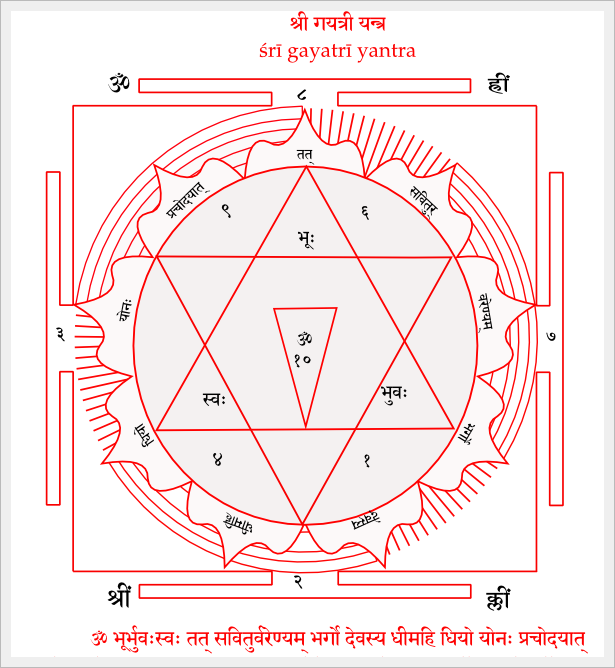
The longer version of Gayatri mantra adds a few more layers of subtlety to both the planes of existence, and the divine entities of the mantra.
ॐ भू: ॐभुव: ॐस्व:
ॐ मह: ॐ जन: ॐ तप: ॐ सत्यम्
ॐ तत्सवितुर्वरेण्यं
भर्गो देवस्यधिमहि
धियो यो न: प्रचोदयात्
ॐआपोज्योतीरासोमृतमब्रह्मभुर्भुव: स्वरोम्।
In the beginning, it adds other higher planes of existence, which are मह: (Mahah),जन: (Janah),तप: (Tapah)and सत्यम्(Satyam).
Along with the initial 3 vyahritis, these 7 higher planes of existence also have a correlation with the 7 chakras of kundalini tantra.
This from of the mantra ends with the words
ॐ आपो ज्योती रासोमृतम ब्रह्म भुर्भुव: स्वरोम् ।
(om apaojyotirasomrtam brahma bhurbhuvahsvarom)
This denotes further divine entities of आप: (aapah), रस: (rasah), अमृतम (amrtam)and ब्रह्म(brahma).It says all of these and the three lokas are within the sound OM itself.
This longer mantra is mentioned in Taittiriya Aranyakaof Yajurveda and is used during sandhya vandana and pranayama. The shorter version is used for japa, or chanting.
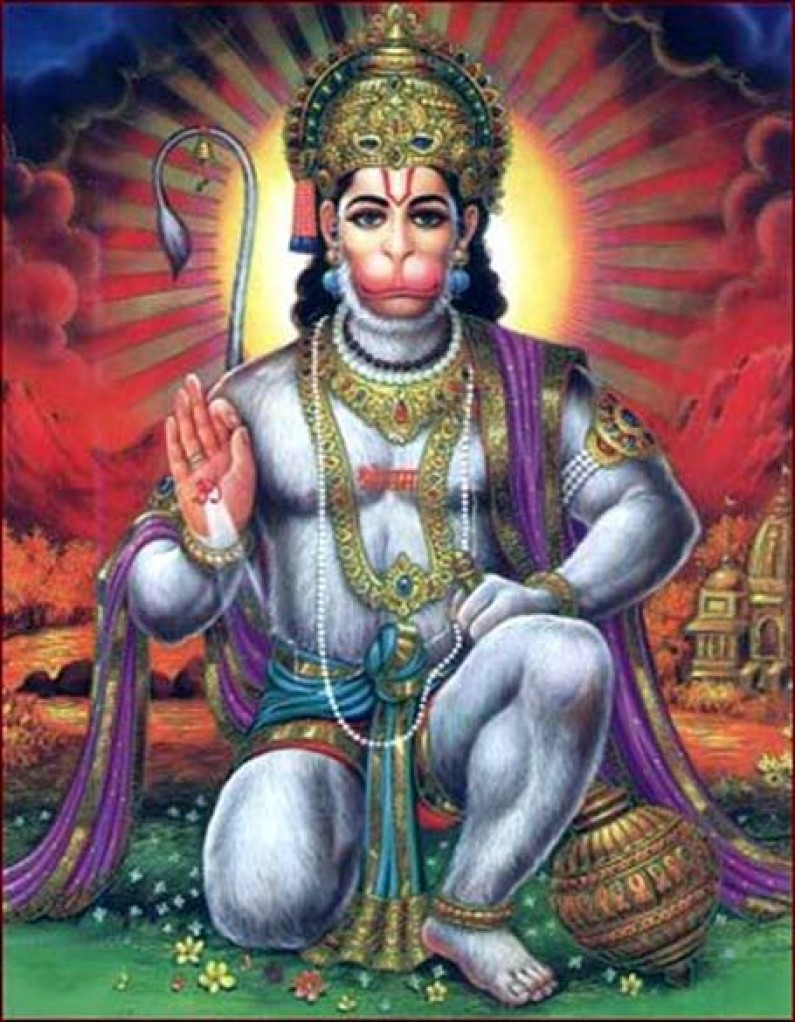
Other Gayatri mantras are also composed of similar words. For example Gayatri mantra for Lord Hanuman is :
ॐ आंजनेयाय विद्महे
वायपुत्रय धीमहि
तन्नो हनुमान् प्रचोदयात्
Aum Anjaneyaya vidmahe
vayuputraya dhimahi
tanno hanuman prachodayat
This means – we realize the son of Anjana Devi, and meditate on the son of the god of winds, Vayu. May Lord Hanuman propel us forward. Here, विद्महे (vidmahe) means we realize or know.
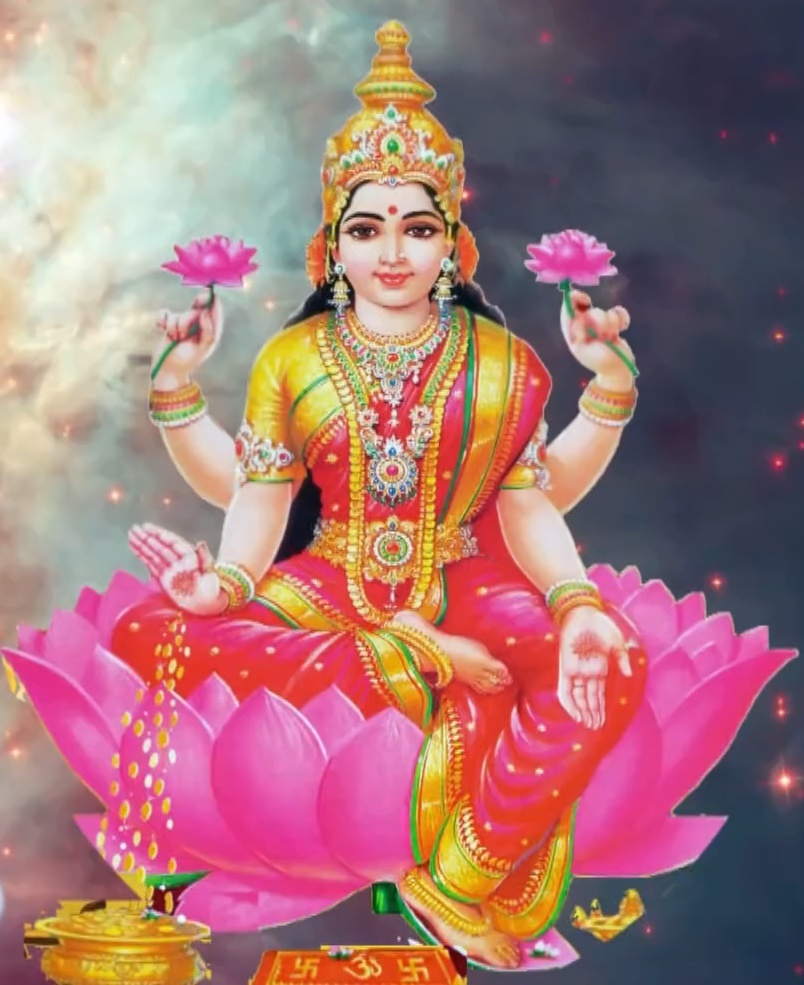
And for Goddess Lakshmi, it is :
ॐ महादेवयै च विद्महे
विष्णुपत्न्यै च धीमहि
तन्नो लक्ष्मी प्रचोदयात्
Aum mahadevyai cha vidmahe
Vishnu patnyai cha dhimahi
Tanno Lakshmi prachodayat
There are many such Gayatri mantras for individual deities, all with the same root words विद्महे, धीमहि, and प्रचोदयात् (vidmahe, dhimahi and prachodayat).
